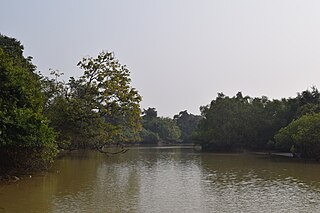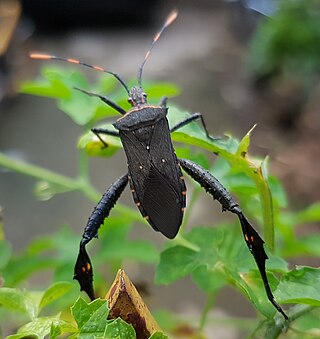
Convolvulaceae, commonly called the bindweeds or morning glories, is a family of about 60 genera and more than 1,650 species. These species are primarily herbaceous vines, but also include trees, shrubs and herbs. The tubers of several species are edible, the best known of which is the sweet potato.

Corixidae is a family of aquatic insects in the order Hemiptera. They are found worldwide in virtually any freshwater habitat and a few species live in saline water. There are about 500 known species worldwide, in 55 genera, including the genus Sigara.

Bhitarkanika Mangroves is a mangrove wetland in Odisha, India, covering an area of 650 km (400 mi) in the Brahmani River and Baitarani River deltas.

The Encyclopedia of Life (EOL) is a free, online encyclopedia intended to document all of the 1.9 million living species known to science. It aggregates content to form "pages" for every known species. Content is compiled from existing trusted databases which are curated by experts and it calls on the assistance of non-experts throughout the world. It includes video, sound, images, graphics, information on characteristics, as well as text. In addition, the Encyclopedia incorporates species-related content from the Biodiversity Heritage Library, which digitizes millions of pages of printed literature from the world's major natural history libraries. The BHL digital content is indexed with the names of organisms using taxonomic indexing software developed by the Global Names project. The EOL project was initially backed by a US$50 million funding commitment, led by the MacArthur Foundation and the Sloan Foundation, who provided US$20 million and US$5 million, respectively. The additional US$25 million came from five cornerstone institutions—the Field Museum, Harvard University, the Marine Biological Laboratory, the Missouri Botanical Garden, and the Smithsonian Institution. The project was initially led by Jim Edwards and the development team by David Patterson. Today, participating institutions and individual donors continue to support EOL through financial contributions.
Labeobarbus macroceps is a species of ray-finned fish in the genus Labeobarbus from The Democratic Republic of the Congo.
The Reptile Database is a scientific database that collects taxonomic information on all living reptile species. The database focuses on species and has entries for all currently recognized ~14,000 species and their subspecies, although there is usually a lag time of up to a few months before newly described species become available online. The database collects scientific and common names, synonyms, literature references, distribution information, type information, etymology, and other taxonomically relevant information.

iNaturalist is an American 501(c)(3) nonprofit social network of naturalists, citizen scientists, and biologists built on the concept of mapping and sharing observations of biodiversity across the globe. iNaturalist may be accessed via its website or from its mobile applications. iNaturalist includes an automated species identification tool, and users further assist each other in identifying organisms from photographs and even sound recordings. As of 25 December 2024, iNaturalist users had contributed approximately 222,324,751 observations of plants, animals, fungi, and other organisms worldwide, and 290,007 users were active in the previous 30 days.

Corixini is a tribe of water boatmen in the family Corixidae. There are about 9 genera and at least 30 described species in the genus Corixini.

Trichocorixa calva is a species of water boatman in the family Corixidae. It is found in North America.

Trichocorixa is a genus of water boatmen in the family Corixidae. There are about 14 described species in Trichocorixa.

Trichocorixa verticalis is a species of water boatman in the family Corixidae. It is found in the Caribbean Sea, Central America, and North America.

Trichocorixa kanza is a species of water boatman in the family Corixidae. It is found in Central America and North America.

Trichocorixa sexcincta is a species of water boatman in the family Corixidae. It is found in the Caribbean Sea, Central America, and North America.
Ectecephala laticornis is a species of grass fly in the family Chloropidae.
Opilioacarus texanus is a species of mite in the family Opilioacaridae.
Aradus implanus is a species of flat bug in the family Aradidae. It is found in North America.

Trichocorixa louisianae is a species of water boatman in the family Corixidae. It is found in the Caribbean Sea, Central America, and North America.
Nausigaster texana is a species of syrphid fly in the family Syrphidae.

Leptoglossus gonagra, known as the passionvine bug, citron bug or squash bug in different parts of its range, is a species of leaf-footed bug in the family Coreidae. It is found in Africa, the Caribbean, Central America, North America, South America, Southern Asia, the Pacific Ocean and Oceania.
The Himalayan long-eared bat, also known as Hodgson's long-eared bat, is a species of bat in the family Vespertilionidae. It is ranges from the Indian subcontinent east to China and south to Vietnam.













